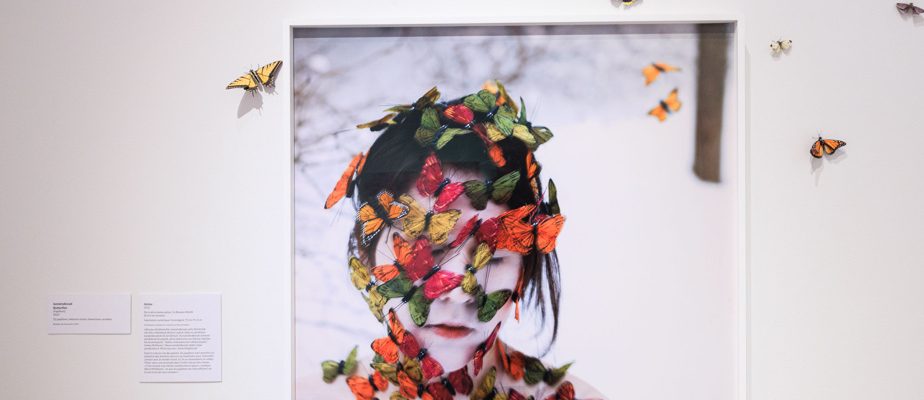It is the Canadian photographer recognized as a major voice in contemporary art, Meryl McMaster, who is mainly in the spotlight this spring at MAJ. She shares the ground floor space with the artist Emma Waltraud Howes, who is having her first individual museum exhibition. Although very different, the projects revisit personal and collective memories experienced or told. These are both stories linked to indigenous communities and experiences of dance: the works show bodies imbued with these stories.

PHOTO HUGO-SÉBASTIEN AUBERT, THE PRESS
Remember The Sky You Were Born Under [Souvenez-vous du ciel qui vous a vu naître] by Meryl McMaster, 2022, giclée print, 40 x 60 inches
Co-produced by the McMichael and Remai Modern collections, and curated by curators Sarah Milroy and Tarah Hogue, Bloodline [Liens du sang] by Meryl McMaster explores the artist’s connections with her Plains Cree/Siksika and British/Dutch ancestors.
At first glance, the 52 butterflies hanging on the picture rails located between the works or above them are surprising. These insects set the tone for the theme, because in Cree culture, they refer to the presence of ancestors when they wish to reconnect with the world of the living. “It’s like I turned into ice […] and that the butterflies breathed life back into me. They wake me up from my sleep,” explains McMaster, on the cartel of the work Anima (2012). These intergenerational relationships are highlighted from the first room.
-
![Works from the Bloodline exhibition [Liens du sang] by Meryl McMaster](https://mobile-img.lpcdn.ca/v2/924x/513a19498143357b8b36d05de9e15b7d.jpg)
PHOTO HUGO-SÉBASTIEN AUBERT, THE PRESS
Works from the exhibition Bloodline [Liens du sang] by Meryl McMaster
-
![Works from the Bloodline exhibition [Liens du sang] by Meryl McMaster](https://mobile-img.lpcdn.ca/v2/924x/6aa67c02960a3cea8c465683cfaca2ec.jpg)
PHOTO HUGO-SÉBASTIEN AUBERT, THE PRESS
Works from the exhibition Bloodline [Liens du sang] by Meryl McMaster
-
![Works from the Bloodline exhibition [Liens du sang] by Meryl McMaster](https://mobile-img.lpcdn.ca/v2/924x/294a80e4b5223563aeb8c4df6c1aea43.jpg)
PHOTO HUGO-SÉBASTIEN AUBERT, THE PRESS
Works from the exhibition Bloodline [Liens du sang] by Meryl McMaster
-
![Works from the Bloodline exhibition [Liens du sang] by Meryl McMaster](https://mobile-img.lpcdn.ca/v2/924x/b693fe1997c93e588e1cc2a4f5d5220e.jpg)
PHOTO HUGO-SÉBASTIEN AUBERT, THE PRESS
Works from the exhibition Bloodline [Liens du sang] by Meryl McMaster
-
![Leave To Me Your Memories [Laissez-moi à vos souvenirs] by Meryl McMaster, 2022, giclée print, 40 x 53 inches](https://mobile-img.lpcdn.ca/v2/924x/aa1519d9fb4d3be498461add6683d433.jpg)
PHOTO HUGO-SÉBASTIEN AUBERT, THE PRESS
Leave To Me Your Memories [Laissez-moi à vos souvenirs] by Meryl McMaster, 2022, giclée print, 40 x 53 inches
1/5
The great strength of Bloodline [Liens du sang] lies in the photographic self-portraits made in a natural landscape for which the artist is famous. In each work, Meryl McMaster presents herself in a unique way: she wears costumes that she makes, inspired by historical and ceremonial outfits, each more original than the last. Recent creations in the series Stories of my grandmothers, designed in 2022, remain faithful to this practice. The works are dedicated to the artist’s grandmothers, 130 years of Cree culture from Red Pheasant in Saskatchewan. To add a poetic and sensitive touch to the proposals, archives are found in the middle of large photographs and a video. Pages from diaries, notes on daily life and vintage photos speak to the artist’s memories and the stories he was told about his family.
Time to dance
If the two exhibitions enter “in dialogue”, to use the words of the interim curator of contemporary art, Marianne Cloutier, it is this staging of bodies and their stories which connects Bloodline [Liens du sang] from Meryl McMaster to The Time it Takes [Le temps qu’il faut] by Emma Waltraud Howes. In both cases, the works form a whole and interact, sometimes through the photographic language of McMaster, sometimes through the choreographic language, among others, of Howes.

PHOTO HUGO-SÉBASTIEN AUBERT, THE PRESS
Dream Catcher [Capteur de rêves]2015, giclée print on hot-pressed paper, 81.3 x 167.6 cm
Coming from classical dance where individual freedom of speech gives way to the collective, Emma Waltraud Howes “danced for others. She embodied the message of others. It became oppressive for her,” explains the curator of the exhibition. The Time it Takes [Le temps qu’il faut], Charlotte Lalou Rousseau. “How do we carry these stories in our body? » was the question that guided his work.
If the creator’s approach is complicated, the curator succeeds in making an effective synthesis of her production. Bang Bang Baroque (2024), a surrealist “opera-anomaly” for three screens, is the flagship project. The artist exploits the codes of opera, but also of heavy metal, techno and baguazhang.
Throughout their discoveries, visitors will recognize through the drawings, sculptures and installations several layers of references ranging from baroque aesthetics to Bertolt Brecht via Inuit legends. “It’s about showing that these ideas have been part of Emma’s practice for several years,” adds Charlotte Lalou Rousseau.
The Manif d’art invites itself to the MAJ
On the second floor, at the very back of the permanent exhibition rooms, The Islands united, devoted to the collection, there are three works from Manif d’art 11 – La biennale de Québec. Curator Marie Muracciole presents video installations by Francis Alÿs, Yto Barrado and Rodney Graham on the themes of conditions of latency and cessation of productivity. This is a first partnership between the event and the MAJ.
And finally, among the visits, you should not miss the tribute to Rodolphe Duguay, Naturally, project supported by curator Julie Alary Lavallée who highlights the 50e anniversary of the artist’s death as well as the youth exhibition prepared by the education department.
Consult the Musée de Joliette website to find out the dates of the different exhibitions
